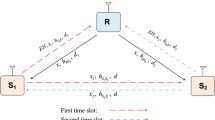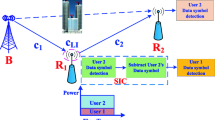Abstract
In this paper, the generalized diversity combining of an energy constrained multiple antenna decode-and-forward relay network is considered. Using power splitting and time switching architectures in consort with diversity combining at the relay, six protocols are proposed, i.e., power splitting with selection combining (PSSC), power splitting with maximum ratio combining (PSMRC), power splitting with generalized selection combining (PSGSC), time switching with selection combining (TSSC), time switching with maximum ratio combining (TSMRC), and time switching with generalized selection combining (TSGSC). The outage probability and throughput performance of each protocol is analyzed by first developing the closed form analytical expressions and then verifying these through the Monte Carlo simulation method. Simulation results show that system performance improves both with increasing the number of antennas and decreasing the distance between the source and relay. The TSSC/TSMRC/TSGSC protocols yield better outage performance whereas the PSSC/PSMRC/PSGSC protocols achieve relatively higher throughput performance. Finally, the effects of power splitting ratio, energy harvesting time ratio, energy conversion efficiency, sample down conversion noise, and the target signal-to-noise ratio on system performance are analyzed and presented.






Similar content being viewed by others
References
Raghunathan V, Ganeriwal S, Srivastava M (2006) Emerging techniques for long lived wireless sensor networks. IEEE Commun Mag 44(4):108–114
Paradiso JA, Starner T (2005) Energy scavenging for mobile and wireless electronics. IEEE Pervasive Comput 4(1):18–27
Xu J, Zhang R (2014) Throughput optimal policies for energy harvesting wireless transmitters with non-ideal circuit power. IEEE Selected Areas Commun 32(2):322–332
Varshney LR (2008) Transporting information and energy simultaneously. In: IEEE international symposium on information theory (ISIT 2008), pp 1612–1616
Grover P, Sahai A (2010) Shannon meets tesla: wireless information and power transfer. In: IEEE international symposium on information theory proceedings (ISIT), pp 2363–2367
Zhang R, Ho CK (2013) MIMO broadcasting for simultaneous wireless information and power transfer. IEEE Trans Wirel Commun 12(5):1989–2001
Liu L, Zhang R, Chua K-C (2013) Wireless information and power transfer: a dynamic power splitting approach. IEEE Trans Commun 61(9):3990–4001
Zhou X, Zhang R, Ho CK (2014) Wireless information and power transfer in multiuser OFDM systems. IEEE Trans Wirel Commun 13(4):2282–2294
Zhou Z, Peng M, Zhao Z, Li Y (2015) Joint power splitting and antenna selection in energy harvesting relay channels. IEEE Sig Proc Lett 22(7):823–827
Ding Z, Perlaza SM, Esnaola I, Poor HV (2014) Power allocation strategies in energy harvesting wireless cooperative networks. IEEE Trans Wirel Commun 13(2):846–860
Son PN, Kong HY (2015) Exact outage analysis of energy harvesting underlay cooperative cognitive networks. IEICE Trans Commun E98-B(4):661–672
Nasir AA, Zhou X, Durrani S, Kennedy RA (2013) Relaying protocols for wireless energy harvesting and information processing. IEEE Trans Commun 12(7):3622–3636
Nosratinia A, Hunter T E, Hedayat (2004) Cooperative communication in wireless networks. IEEE Commun Mag 42(10):74–80
Laneman JN, Tse DNC, Wormell GW (2004) Cooperative diversity in wireless networks: efficient protocols and outage behavior. IEEE Trans Inf Theory 50(12):3062–3080
Touati S, Boujemmaa H, Abed N (2015) Static hybrid multihop relaying and two hops hybrid relaying using DSTC. Ann Telecommun 70(3):171–180
Alouane WH, Hamdi N, Meherzi S (2014) Semi-blind amplify-and-forward in two-way relaying networks. Ann Telecommun 69(9):497–508
Alouane WH, Hamdi N (2015) Semi-blind two-way AF relaying over Nakagami-m fading environment. Ann Telecommun 70(1):49–62
Alouane WH, Hamdi N (2015) Performance analysis of semi-blind two-way AF relaying over generalized-k fading channels. Ann Telecommun 70(9):381–394
Duong TQ, Zepernick H-J, Bao VNQ (2009) Symbol error probability of hop-by-hop beamforming in Nakagami-m fading. IEEE Electron Lett 45(20):1042–1044
Liu Y, Wang L, Elkashlan M, Duong TQ, Nallanathan A (2014) Two-way relaying networks with wireless power transfer: Policies design and throughput analysis. In: Proceedings of IEEE global telecommunications conference (GLOBECOM2014), Austin, pp 4030–4035
Nguyen DK, Matthaiou M, Duong TQ, Ochi H RF energy harvesting two-way cognitive DF relaying with transceiver impairments. In: Proceedings of IEEE international communications conference (ICC15), London, pp 1970–197
Miridakis NI, Vergados DD (2014) Generalized diversity reception in the presence of multiple distinct interferers: an outage performance analysis. IEEE Trans Wirel Commun 13(5):2443–2453
Deng Y, Wang L, Elkashlan M, Kim KJ, Duong TQ (2015) Generalized selection combining for cognitive relay networks over Nakagami-m fading. IEEE Trans Sig Proc 63(8):1993–2006
Krikidis I, Sasaki S, Timotheou S, Ding Z (2014) A low complexity antenna switching for joint wireless information and energy transfer in MIMO relay channels. IEEE Trans Commun 62(5):1577–1587
Bhaskar V, Vivek GR (2015) Spectrum efficiency evaluation of LMF channels under various adaptation policies with hybrid diversity schemes. Ann Telecommun. Springer, doi:10.1007/s12243-015-0476-5
Gradshteyn IS, Ryzhik IM (2007) Table of integrals, series and products, 7th edn. Academic Press
Abramowitz M, Stegun IA (1964) Handbook of mathematical functions with formulas, graphs and mathematical tables. Dover Publications, United States
Ikki SS, Aissa S (2011) Effects of co-channel interference on the error probability performance of multi-hop relaying networks. In: Proceedings of IEEE global telecommunications conference (GLOBECOM2011), pp 1–5
Alouini M-S, Simon MK (1999) Performance analysis of generalized selective combining over Rayleigh fading channels. In: Communication theory mini-conference, pp 110–114
Acknowledgments
This work was supported by the 2017 Research Fund of University of Ulsan.
Author information
Authors and Affiliations
Corresponding authors
Appendices
Appendix A: Proof of equation (12.3)
The first probability in (12.2), \(\Pr \left [ {\upsilon \psi {g_{\mathrm {X}}} < {\psi _{t}}} \right ]\), is expressed under the CDF of RV g X as
where \(\varphi \triangleq \frac {{{\psi _{t}}}}{{\upsilon \psi }}\).
The second probability in (12.2), \(\Pr \left [ {\upsilon \psi {g_{\mathrm {X}}} \ge {\psi _{t}},\omega \psi {g_{\mathrm {X}}}{g_{2}} < {\psi _{t}}} \right ]\), is given by
where \(\theta \triangleq \frac {{{\psi _{t}}}}{{\omega \psi }}\), \({f_{{g_{\mathrm {X}}}}}\left (x \right )\) is the PDF of RV g X; (A2.2) is obtained by substituting the CDF \({F_{{g_{2}}}}\left ({\frac {{{\psi _{t}}}}{{\omega \psi x}}} \right ) = 1 - {e^{ - \frac {{{\lambda _{2}}{\psi _{t}}}}{{\omega \psi x}}}}\) into (A2.1); (A2.3) is obtained by substituting \(\int _{\varphi }^{\infty } {{f_{{g_{\mathrm {X}}}}}(x)dx} = 1 - \int _{0}^{\varphi } {{f_{{g_{\mathrm {X}}}}}(x)dx} = 1 - {F_{{g_{\mathrm {X}}}}}\left (\varphi \right )\) into (A2.2).
Combining Eqs. A1 and A2, we finish the proof for equation (12.2).
Appendix B: Proof of \(P_{out}^{PSSC}\)
Firstly, the CDF of g SC is given by
The PDF of g SC can be obtained by differentiating (B1)
Secondly, from the binomial theorem \({\left ({u + v} \right )^{n}} = \sum \limits _{k = 0}^{n} {{C_{n}^{k}}{u^{n - k}}{v^{k}}} \) [27, pp. 10], where \({C_{n}^{k}} = \frac {{n!}}{{k!\left ({n - k} \right )!}}\). We obtain the following result:
Then, \(P_{out}^{PSSC}\) can be rewritten by
We note that \(\theta = \frac {{{\lambda _{2}}{\psi _{t}}}}{{\omega \psi }} \approx 0\) and \(\varphi = \frac {{{\psi _{t}}}}{{\upsilon \psi }} \approx 0\) when ψ is high. Thus, the integral \(\int _{0}^{\varphi } {{e^{ - {\lambda _{1}}\left ({k + 1} \right )x - {\lambda _{2}}\theta /x}}dx} \) is insignificant due to \(\frac {{{\psi _{t}}}}{{\upsilon \psi }} \approx 0\), and \(\int _{0}^{\varphi } {{e^{ - {\lambda _{1}}\left ({k + 1} \right )x - {\lambda _{2}}\theta /x}}dx} \) can be approximated to \(\int _{0}^{\varphi } {{e^{ - {\lambda _{1}}\left ({k + 1} \right )x}}dx} \). We obtain:
Finally, \(P_{out}^{PSSC}\) can be expressed by using the formula \(\int _{0}^{\infty } {{e^{ - \frac {\beta }{{4x}} - \gamma x}}dx = \sqrt {\frac {\beta }{\gamma }} } {K_{1}}\left ({\sqrt {\beta \gamma } } \right )\) [26, Eq. 3.324.1], where \({K_{1}}\left (. \right )\) is the first-order modified Bessel function of the second kind
This finishes the proof of \(P_{out}^{PSSC}\).
Appendix C: Proof of \(P_{out}^{PSM\!RC}\)
Firstly, because g MRC is summation of i.i.d. exponential RVs, its PDF is given from [28, Eq. 12] as
Then , we rewrite \(P_{out}^{PSMRC}\) as
Using the formula \({\int _{0}^{u}} {{x^{v - 1}}{e^{ - \mu x}}dx} = {\mu ^{ - v}}\gamma \left ({v,\mu u} \right )\) [26, Eq. 3.381.1] and \(\int _{0}^{\infty } {{x^{v - 1}}{e^{ - \frac {\beta }{x} - \gamma x}}dx} = 2{\left ({\frac {\beta }{\gamma }} \right )^{v/2}}{K_{v}}\left ({2\sqrt {\beta \gamma } } \right )\) [26, Eq. 3.471.9], where K v (.) is a modified Bessel function of the second kind, \(\gamma \left ({v,\mu u} \right )\) is the incomplete gamma function and it is defined by \(\gamma \left ({v,\mu u} \right ) \triangleq \int _{0}^{\mu u} {{e^{ - t}}{t^{v - 1}}dt} = \int _{0}^{\infty } {{e^{ - t}}{t^{v - 1}}dt} - \int _{\mu u}^{\infty } {{e^{ - t}}{t^{v - 1}}dt} = \Gamma \left (v \right ) - \Gamma \left ({v,\mu u} \right )\) [26, Eq. 8.350.1], with \(\Gamma \left (v \right ) \triangleq \int _{0}^{\infty } {{e^{ - t}}{t^{v - 1}}dt} \) [26, Eq. 8.310.1], \(\Gamma \left ({v,\mu u} \right ) \triangleq \int _{\mu u}^{\infty } {{e^{ - t}}{t^{v - 1}}dt} \) [26, Eq. 8.350.2]. We obtain the following results
Substituting Eqs. C3a and C3b into Eq. C2, \(P_{out}^{PSMRC}\) is given by
This finishes the proof of \(P_{out}^{PSMRC}\).
Appendix D: Proof of \(P_{out}^{PSGSC}\)
Firstly, the PDF of g GSC is given from [29, Eq. 8] as
Then, \(P_{out}^{PSGSC}\) can be rewritten by
where \({I_{1}} \triangleq \int _{\varphi }^{\infty } {{x^{L - 1}}{e^{ - {\lambda _{1}}x - {\lambda _{2}}\theta /x}}dx} \), \({I_{2}} \triangleq \int _{\varphi }^{\infty } {{e^{ - \left ({{\lambda _{1}} + \frac {{l{\lambda _{1}}}}{L}} \right )x - {\lambda _{2}}\theta /x}}dx} \), and \({I_{3}} \triangleq \int _{\varphi }^{\infty } {{x^{m}}{e^{ - {\lambda _{1}}x - {\lambda _{2}}\theta /x}}dx} \).
The expression of integrals I 1, I 2, and I 3 can be given by
where (D3a.2), (D3b.2) and (D3c.2) are obtained by approximating \(\int _{0}^{\varphi } {{x^{L - 1}}{e^{ - {\lambda _{1}}x - {\lambda _{2}}\theta /x}}dx} \approx \int _{0}^{\varphi } {{x^{L - 1}}{e^{ - {\lambda _{1}}x}}dx} \), \(\int _{0}^{\varphi } {{e^{ - \left ({{\lambda _{1}} + \frac {{l{\lambda _{1}}}}{L}} \right )x - {\lambda _{2}}\theta /x}}dx} \approx \int _{0}^{\varphi } {{e^{ - \left ({{\lambda _{1}} + \frac {{l{\lambda _{1}}}}{L}} \right )x}}dx} \) and \(\int _{0}^{\varphi } {{x^{m}}{e^{ - {\lambda _{1}}x - {\lambda _{2}}\theta /x}}dx} \approx \int _{0}^{\varphi } {{x^{m}}{e^{ - {\lambda _{1}}x}}dx} \), respectively. (D3a.3), (D3b.3) and (D3c.3) are attained by using \({\int _{0}^{u}} {{x^{v - 1}}{e^{ - \mu x}}dx} = {\mu ^{ - v}}\gamma \left ({v,\mu u} \right )\) and \(\int _{0}^{\infty } {{x^{v - 1}}{e^{ - \frac {\beta }{x} - \gamma x}}dx} = 2{\left ({\frac {\beta }{\gamma }} \right )^{v/2}}{K_{v}}\left ({2\sqrt {\beta \gamma } } \right )\). Substituting Eqs. D3a, D3b, and D3c into Eq. D2, the proof is concluded.
Rights and permissions
About this article
Cite this article
Nguyen, S.Q., Kong, H.Y. Generalized diversity combining of energy harvesting multiple antenna relay networks: outage and throughput performance analysis. Ann. Telecommun. 71, 265–277 (2016). https://doi.org/10.1007/s12243-016-0508-9
Received:
Accepted:
Published:
Issue Date:
DOI: https://doi.org/10.1007/s12243-016-0508-9




